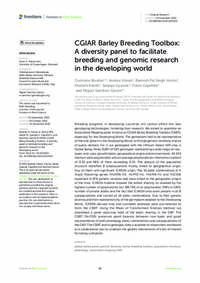CGIAR Barley Breeding Toolbox: A diversity panel to facilitate breeding and genomic research in the developing world

Authors:
Breeding programs in developing countries still cannot afford the new genotyping technologies, hindering their research. We aimed to assemble an Association Mapping panel to serve as CGIAR Barley Breeding Toolbox (CBBT), especially for the Developing World. The germplasm had to be representative of the one grown in the Developing World; with high genetic variability and be of public domain. For it, we genotyped with the Infinium iSelect 50K chip, a Global Barley Panel (GBP) of 530 genotypes representing a wide range of row-types, end-uses, growth habits, geographical origins and environments. 40,342 markers were polymorphic with an average polymorphism information content of 0.35 and 66% of them exceeding 0.25. The analysis of the population structure identified 8 subpopulations mostly linked to geographical origin, four of them with significant ICARDA origin. The 16 allele combinations at 4 major flowering genes (HvVRN-H3, HvPPD-H1, HvVRN-H1 and HvCEN) explained 11.07% genetic variation and were linked to the geographic origins of the lines. ICARDA material showed the widest diversity as revealed by the highest number of polymorphic loci (99.76% of all polymorphic SNPs in GBP), number of private alleles and the fact that ICARDA lines were present in all 8 subpopulations and carried all 16 allelic combinations. Due to their genetic diversity and their representativity of the germplasm adapted to the Developing World, ICARDA-derived lines and cultivated landraces were pre-selected to form the CBBT. Using the Mean of Transformed Kinships method, we assembled a panel capturing most of the allelic diversity in the GBP. The CBBT (N=250) preserves good balance between row-types and good representation of both phenology allelic combinations and subpopulations of the GBP. The CBBT and its genotypic data is available to researchers worldwide as a collaborative tool to underpin the genetic mechanisms of traits of interest for barley cultivation.
